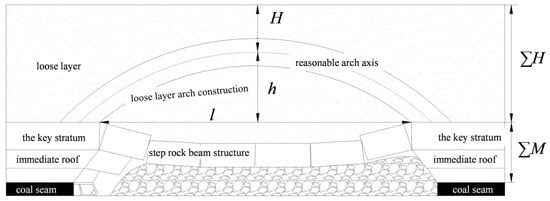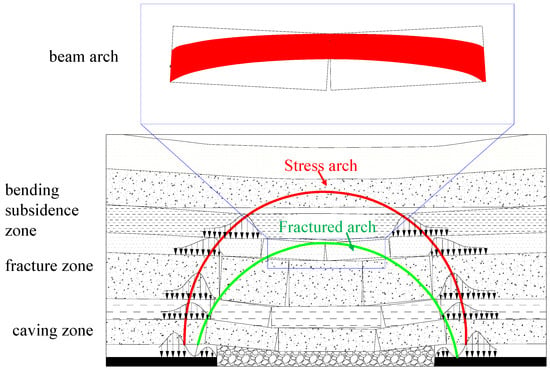You're using an outdated browser. Please upgrade to a modern browser for the best experience.
Please note this is a comparison between Version 1 by Cun Zhang and Version 3 by Dean Liu.
The application of the arch structure model focuses on the prediction and prevention of mining pressure and surface subsidence, and there are relatively few means to actively regulate overburden arch.
- underground coal mining
- arch structure model
- unconsolidated layer arch
1. Introduction
The structure model of overlying strata in mining fields can be used to describe strata movement and predict mine disasters [1][2][3][1,2,3]; it is the foundation of safe mining in underground coal mines. The overburden structure theories and hypotheses proposed for mine pressure and rock strata control mainly include: key strata theory [4][5][6][4,5,6], transfer rock beam hypothesis [7], masonry beam theory (articulated rock block hypothesis) [8], hypothesis of pre-cracked beam [9], cantilever beam hypothesis [10], and the stress arch hypothesis [11]. These theories and hypotheses have been widely used and developed in coal mining. For example, the key strata theory has been applied in working face periodic pressure and support resistance prediction [4], the development of water flowing fracture zones [6], filling, mining, and surface subsidence [12][13][12,13], rockburst prevention and control [14], pressure relief mining and gas extraction [15], water inrush prediction from the floor [16], and grouting in separated layers [17]. The transfer rock beam hypothesis has led to important achievements in the innovation of mining methods and mining technologies, as well as the control practice of major accidents and disasters, such as the design of mining methods without coal pillars, the calculation of support resistance, the prediction of three-zone height, the prevention and control of rockburst, coal, and gas outburst, etc. [7][18][7,18]. Masonry beam theory, preformed fracture beam hypothesis and cantilever beam hypothesis all reveal the fracture and migration characteristics of overburden rock above the working face with the beam model, and provide the prediction model of mining pressure of the working face under specific geological conditions and mining parameters. The arch structure model, evolved on the basis of the beam model, can not only analyze the near-field mine pressure law, but also explain the characteristics of overburden and surface migration in the far field, which is widely used in the analysis of overburden fracture migration in coal mining. For example, in the process of coal seam mining, due to the existence of the stress arch, the adjacent coal seams will generate a stress increase zone and stress relief zone. If the adjacent coal seam is in the stress relief zone, the gas seepage capacity of the coal seam will be greatly improved, which is conducive to the gas drainage of the coal seam [19][20][19,20].
2. Construction of Arch Structure Model
2.1. Model of Unconsolidated Layer Arch Model
The geological conditions of the thick unconsolidated layer are widely distributed in some mining areas in East China and North China, such as Huainan, North Anhui, Huaibei, Yanzhou, Xinwen, Kailuan, and other mining areas. The maximum thickness of the unconsolidated layer in 48 coal mines is 752 m, the minimum is 100 m, and the average is 319 m. It is found, from this measurement, that in the mining of the shallow coal seam, the load of the thick unconsolidated layer (mainly viscous unconsolidated layer) does not act on the main roof at once, and there is an arch-bearing structure, as shown in Figure 12. Therefore, the load of the unconsolidated layer on bedrock cannot be simply equal to the weight of the unconsolidated layer, and it is necessary to study the evolution process of the unconsolidated layer arch model. At present, studies on the unconsolidated layer arch mainly focus on the geological conditions of the shallow buried thick unconsolidated layer, and analyze the influence of the unconsolidated layer arch on surface subsidence, fracture development, and the unconsolidated layer on bedrock load [21][22][37,38].
Figure 12. Unconsolidated layer arch structure in mining overburden. l–Span of arch structure; h–height of arch structure; H–burial depth of arch crown; ∑H–thickness of unconsolidated layer; ∑M–thickness of bedrock.
2.2. Arch Structure Model of Overlying Rock
- (1)
-
Linear arch (beam arch)
 Figure 23.Overburden arch structure based on beam arch structure.
Figure 23.Overburden arch structure based on beam arch structure.- (2)
-
Overburden arch (stress arch, fracture arch)
 Figure 34.Evolution characteristics of far- and near-field stress arch in overburden.
Figure 34.Evolution characteristics of far- and near-field stress arch in overburden.
